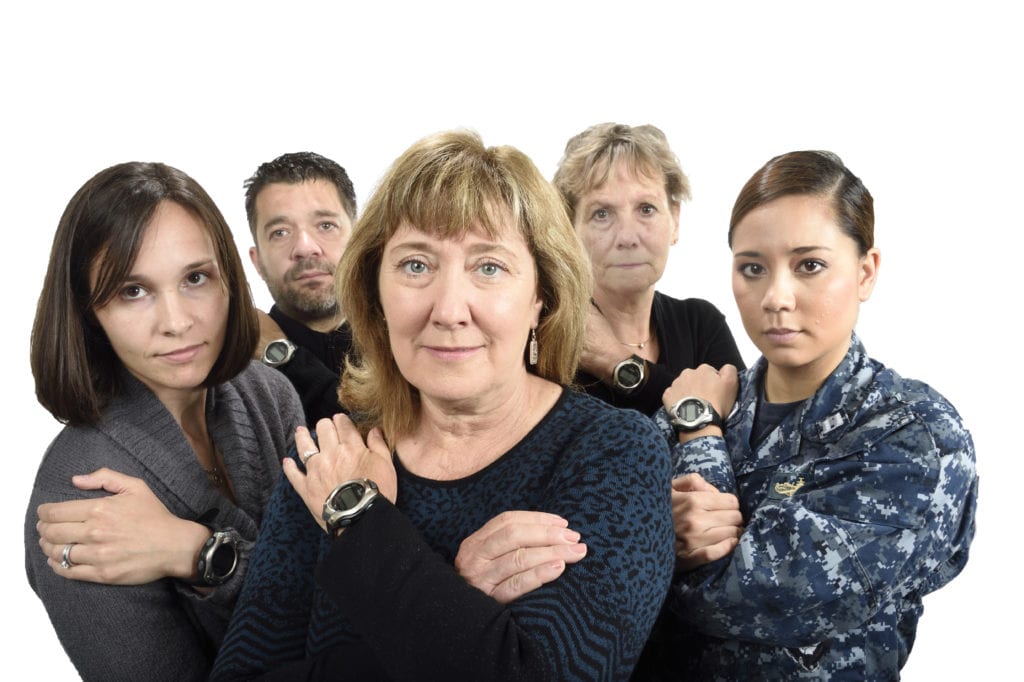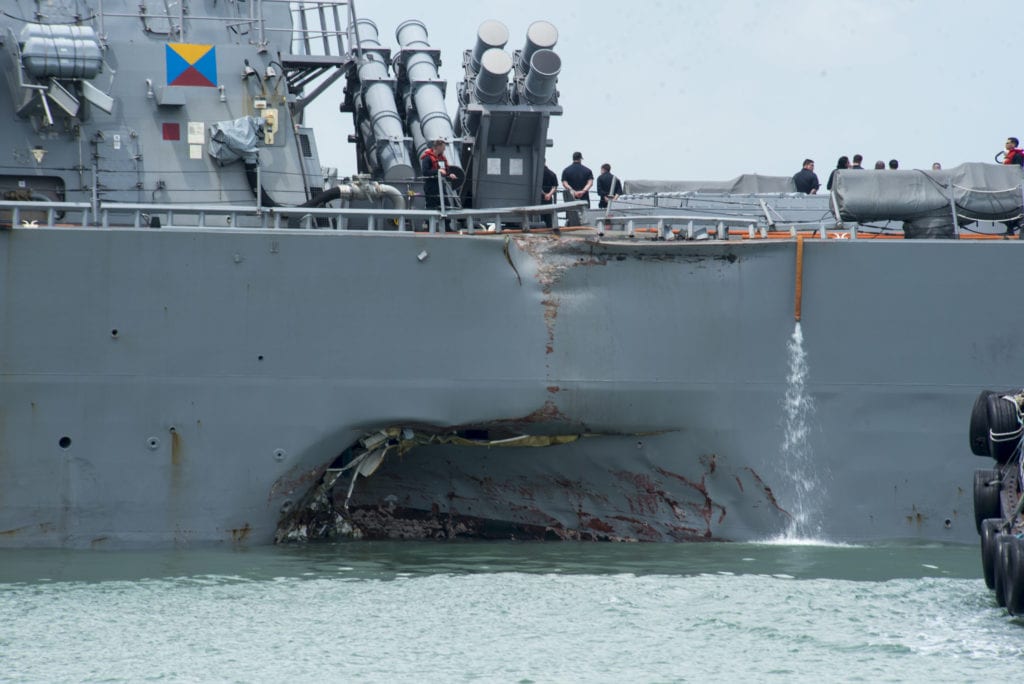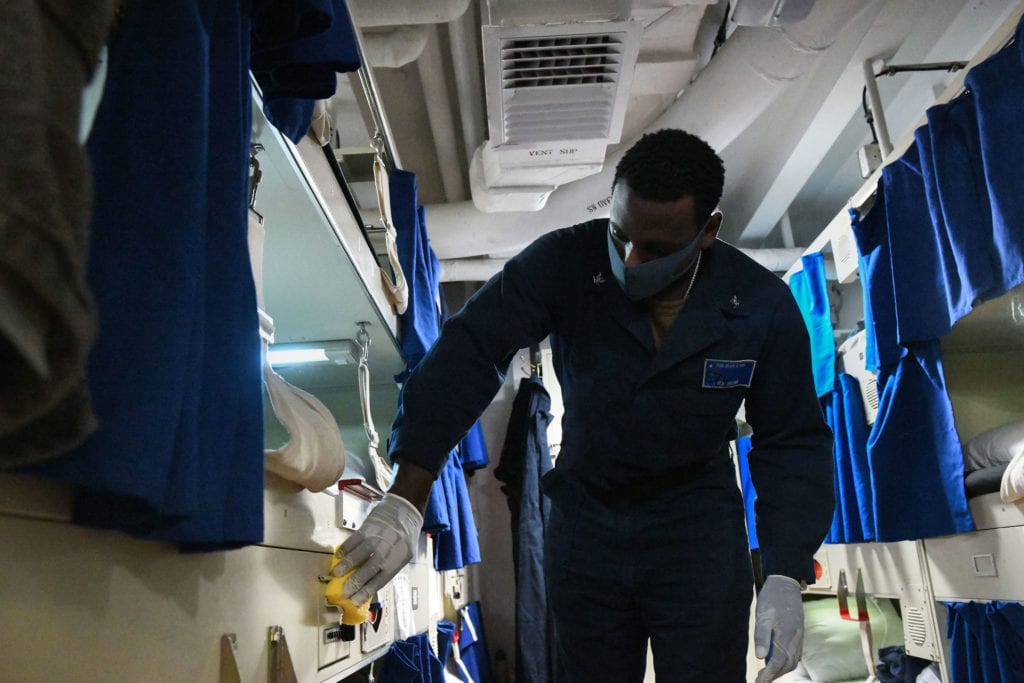
Lack of sleep is problem that’s long dogged sailors at sea. Insomnia and general fatigue often are blamed for leading to mistakes, mishaps and collisions at sea, some fatal.
It’s not just anecdotal. Recent research studies have found long workdays and inconsistent sleep schedules driven by varying watchbills, undermanned crews, busy shipboard routines and high-operational tempo created fatigued crews. Limited time for rest and even noise and bright lights cut into getting a good slumber at sea.
The problem became obvious in 2017 when guided-mis- sile destroyers USS Fitzgerald (DDG 62) ran into a cargo ship and USS John McCain (DDG 56) collided with a tank- er ship in the predawn hours, the latter which resulted in the deaths of 10 Sailors. Then-Chief of Naval Operations Adm. John Richardson told a congressional committee several months later that “both of these accidents were preventable” and he ordered an overhaul of how the fleet trains, mans and operates to prevent future mishaps and bolster safer operations.
Along with recent adoptions across the surface fleet of watchbills providing more consistent periods for sleep and rest, new research projects are using high-tech devices and collecting data to fine-tune those changes and identify ways for skippers and crews to sleep more soundly and perform better, whether at sea, in the air or in the field. Researchers already are finding simple, low-tech solutions to thwart light and sound to ensure a sounder snooze at sea. And the “Crew Endurance” team at Naval Postgraduate School in Monterey, Cali- fornia, is developing online training tools and videos to help skippers and Sailors become a well-rested, more focused force.
Navy officials “are changing the culture about sleep,” said Nita Shattuck, operations research professor at Naval Postgraduate School, who leads the Crew Endurance team. “It’s been slow in coming, but I absolutely think it’s happening.”
Shattuck has spent more than 30 years studying sleep, fatigue and performance issues in the Navy, Coast Guard and Marine Corps, and her work has led to the recent changes in watchbills. “There’s still more work to be done,” she said, “but I think they’ve made huge inroads.”

Lack of Sleep
Adults need seven hours of sleep, at a minimum, but the National Sleep Foundation estimates that nearly one- third of adults averaged fewer than six hours. There’s a cost to fatigue — especially at sea.
USS John McCain’s bridge watch team, including the com- manding officer and executive officer, averaged nearly five hours of sleep in the previous 24 hours before the collision due to shifting watch schedules and lack of sleep- ing time, the National Transportation Safety Board found. Moreover, the “bridge watchstanders, particularly the lee helmsman, were acutely fatigued at the time of the accident, which impacted their situation awareness and their ability to respond to the perceived steering emergency.”
The collision happened at 5:24 a.m. in the Singapore Strait, a time which NTSB noted was “considered to be a circadian low (roughly 2 a.m. to 6 a.m.), when the body is normally more fatigued and prone to diminished alertness and degraded performance,” and the ship’s shifting watch schedules changed sleep periods daily, “which compounds fatigue related to lack of sleep and circadian lows.”
Circadian rhythms are the body’s internal clock based on the 24-hour periods of daylight and dark, but according to the National Sleep Foundation, “a disturbed sleep-wake circadian rhythm can give rise to serious sleeping problems.”
Undoubtedly, the 2017 collisions — along with prior collision of the guided-missile cruiser USS Lake Champlain (CG 57) with a fishing boat and grounding by USS Antietam (CG 54) — shook the Navy. Just months later, Naval Surface Force leaders ordered changes to give crews sufficient rest and sleep.
“The role exhaustion played in the four incidents in 2017 varies from ship to ship; however, there is no debate about the wisdom of implementing circadian rhythm–based watchbills and shipboard routines on surface force ships to provide predictable, protected periods of sleep for our Sailors and optimize alertness and recuperation,” then-Vice Adm. Thomas S. Rowden, Surface Force commander, wrote in a 2018 paper, “Surface Forces are Refocused,” directing all ships to implement those principles or incorporate circadian-rhythm principles.
Shattuck noted the surface fleet moved quickly as it already was working on improvements driven by ongoing research into fatigue and sleep. But previous years’ mishaps had met with little appetite to institute changes, even after earlier studies found links between sleep and performance.
In 2002, a study found shifting a ship’s crew from day to night air operations disrupted sleep and caused fatigue for “a large number” of Sailors, who slept during day- light hours and worked all night. Participants in the study on USS John C. Stennis (CVN 74), deployed supporting combat operations in Afghanistan, wore watch-like ActiGraphs on their wrist that collected sleep and activity data and logged their sleep, work and other activities. The workday ran from about 6 p.m. until 10 a.m. the next day.
After 30 days, Sailors reported less sleep, especially those who spent any time outside. “It is evident that sleep deprivation and fatigue due to the reversed schedule was a major problem for many of the participants in this study, Shattuck and Lt. John Nguyen wrote in the May 2003 paper for the Aerospace Medical Association. They added, “other factors may have contributed to the differences observed in sleep hours and predicted effectiveness, (e.g., working conditions, light exposure levels, type of work performed, health issues and combat stress).”
New Studies
In the two decades since that study, amid higher optempos and combat operations in Afghanistan and Iraq, military researchers and sleep labs across the services, including NPS, Naval Health Research Center in San Diego and Walter Reed National Military Medical Center in Bethesda, Maryland, have been delving into sleep and operational performance. NPS researchers have more than a half-dozen projects focused on sleep issues and solutions. These include projects on fully manned watches, sleep inertia, leaders and stress inoculation, aviator sleep and video gaming.
In one study of circadian-based watch schedules, an NPS team is collecting sleep data on guided-missile destroyer USS Gonzalez (DDG 66) “to see how are people implementing that,” Shattuck said. The study is looking at the ship’s engineering department, which got additional personnel to round out requirements, “so we are looking to see how does extra manning affect workload and sleep?
“Ships are always undermanned,” she noted, “but we’re looking to see what would happen if they do have the manning that the Navy says that they need.”
Another study focuses on sleep inertia. Someone jolted awake from deep sleep usually feels a disorienting brain fog or grogginess for some time, but that can be a critical decision-making time when out at sea. A study is looking at the problem to find ways to make that transition to full attention and performance quicker, and safer.
“How can we help somebody, like a commanding officer, if something happens in the middle of the night [and] you’ve got to awaken and make decisions?” Shattuck said. “We are monitoring people’s brainwaves with an EEG [electroencephalogram] and monitoring their sleep, so we’ll see when they go into deep sleep, we awaken them.” They then sit up and do a battery of tests and are “either exposed to bright light or to an olfactory stimulus, like a smell like wasabi … that’ll awaken them.”
A study kicked off in early January at Surface Warfare Officers School, where researchers are monitoring prospective COs and XOs “to see how they can help them perform better in case of emergencies, if something happens,” Shattuck said, focusing on leaders and stress inoculation.
The officers will use the wearable titanium Oura ring and armband stress monitors to track heart rate and other data as they go through several trainers and tests. “We’re collecting physiological data in these prospective COs and XOs and basically documenting what they’re doing to them,” she said.
In a study on aviator sleep requested by the Marine Corps, NPS researchers are using bright lights and a flight simulator in the NPS sleep lab to see how they could be used to help adjust aviators’ internal clock by tracking melatonin levels in transitioning between day and night flight schedules. Exposure to high-energy, blue-enhanced white light at their “normal” bedtime will hasten what’s called “Circadian entrainment,” Shattuck said, and presumably help them for that night flight simulating F/A-18 Hornet jet missions of several hours in different light conditions.
“So you’ve been flying days and now we’ve got to transition you to flying nights safely, and how do we do that?” she said. The study also seeks to determine how long it takes to adjust to the new schedule and how flight performance is impacted.
Two new separate studies by NPS will look at the prevalence of video gaming in the Marine Corps and in the Navy. Some recent studies have shown psychological benefits to video gaming but also problems including addiction, insomnia and lower performance.
Shattuck has seen the problem firsthand at sea among Sailors and Marines during her sleep research. “I’ve collected all of this data on ships and we’ve ridden the ships and … here are these folks that are supposed to be sleeping and they’re on the mess decks or they’re in their racks playing video games,” she said. Playing an occasional video game “is totally understandable, it’s just kind of a way to decompress, perhaps. But when you’re doing it to the exclusion of sleeping and having it impact your work and that’s what we’re concerned about.”

Low-Tech Solutions
With noise and bright lights a constant on ship, another study is looking at whether thicker curtains on berthing racks can help Sailors get better sleep. Earlier this year, NPS bought and installed 300 pairs of heavy, flame-retardant canvas rack curtains on the guided-missile destroyer USS Paul Hamilton (DDG 60) and, with the help of wrist activity monitors, researchers are tracking the quality of sleep the crew gets.
The curtains reduce light intrusion and have pockets where Sailors can stash personal items. “Oh yeah, they love them,” Shattuck said. The curtains are made by NavyRackPacks, a small company founded by a Navy spouse and sold online and in some exchanges.
NPS also has distributed to ships’ crews involved in ongoing studies “warfighter sleep kits” that include eye coverings, a sleep mask that is convex so it doesn’t press against the eyes, a set of soft ear plugs and a card with advice about sleep, she said.
“They’re so nice to let us to come out and study the ship and everything, I want to do something nice for the crew,” she added.
- Ships and Human Performance: Surface Forces Take Holistic Approach to Sailors, Crew Training - December 20, 2022
- From Submarine to Mars Explorer, Discovery is this Navy Veteran’s Mission - September 16, 2021
- Fatigue at Sea: Researching How Lack of Sleep Can Affect Sailors - February 25, 2021




